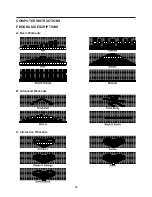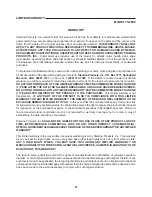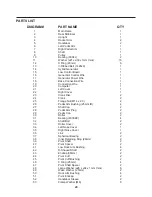
COMPUTER INSTRUCTIONS
20
PROGRAM DESCRIPTIONS
(continued)
A. Basic Workouts
C. Interactive Workouts
1. Hill:
Increasing interval resistance levels (hills) that have brief resistance level reductions between
increases, followed by a plateau of a steady state resistance level and then a gradual cool-down.
2. Hike:
Slow, steady increase in resistance levels to a peak value (based upon level chosen) and
then a slow steady decrease in resistance levels to a valley.
3. Speed Change:
The message center prompts the user to perform increases and decreases in
RPM (every 30 seconds) to simulat
e interval speed and resistance level training.
4. Random:
Increases in resistance levels (hills) followed by
"
random
"
decreases in resistance
levels (valleys). Both the increases/decreases and duration of the changes are random.
5. Ascent:
Moderate, steady increase in resistance level to a peak value (based upon level chosen)
and then a slow steady decrease in resistance level to a valley.
6. Manual:
User controls the resistance level.
B. Advanced Workouts
1. Fat Burn:
Resistance levels automatically increase/decrease to keep user's heart rate at 65%
of ACSM (American College of Sports Medicine) theoretical max.
2. Peaks & Valleys:
Resistance levels moderately increase and decrease to keep user's heart
rate moving back and forth between 65% and 80% of ACSM theoretical max.
3. Switch Back:
Resistance levels rapidly increase and decrease to keep user's heart rate
moving between 65% and 80% of ACSM theoretical max.
4. Cardio:
Resistance levels automatically increase and decrease to keep user's heart rate at
80% of ACSM theoretical max.
5. Pace:
The message center prompts the user to increase heart rate by increasing and
decreasing RPM to achieve user's heart rate at 70% of ACSM theoretical max.
1. Push-Pull:
Prompts the user to concentrate on alternately pushing and pulling with their
upper body over a given time period.
2. Kick-It:
Prompts the user to increase speed (after two minute warm-up) to plus 20 RPM over
warm-up speed for one minute, then prompts the user to reduce by 10 RPM for one minute. The
user continues to increase RPM by 20 for one minute and decrease RPM by 10 for one minute
until reaching a maximum RPM. After reaching the maximum RPM the user then begins to
decrease RPM by 20 for one minute and then increase RPM by 10 for one minute. This
decreasing pattern repeats until the user is back at his starting warm-up RPM. This is a finite
program that goes up to a max of 90 RPM based on the total time entered.
3. Total Body:
Prompts the user to concentrate on pushing and pulling with upper body, as
well as changing direction (forward and backward) and using lower body only.
4. Back & Forth:
Prompts the user to change direction back and forth over a given time
period.












































